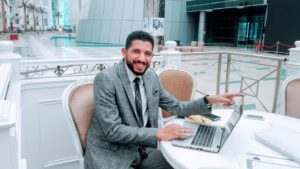
Learning among students can be improved by expressing the concepts through physical expressions, observes Bahaa Mohamed Eltahawy, Educational Consultant & Teacher, GEMS Wellington International School, for Elets News Network (ENN).

At the end of the last century, renowned American psychologist Howard Gardner published the theory of multiple intelligences. Though there are those who say that there is a precedent to discover it, famous Egyptian historian and writer Ahmed Amin published an article on the same subject. The summary of both the renowned personalities’ work is that to involve all your students in your lessons, teachers should have as many different ways imparting knowledge as the types of learners they have.
There is no doubt that both educators and teachers consider every child unique in terms of their learning abilities, talents and behaviour. Considering it, GEMS Wellington International School has tried its best to cater to needs of all the learners in the classrooms. Staff of the school always tries to understand the differences in the learning patterns of every student individually. Today, the school has a new and innovative way to look after a large segment of students having different learning patterns.
At Gems, the patterns of learning varied into the following types:
Visual (spatial – visual): This methodology uses images and info graphics to make students learn different concepts.
Auditory (auditory-musical): This style learns more by listening. Teachers can apply this by integrating music and melodies to their lessons.
Verbal (linguistic): This style performs better in terms of words and terminology and is proficient in the use of words.
Physical (kinesthetic): This style uses lots of body language and movements to improve learning among students.
Logical intelligence (logical): This style uses logic, philosophy, and reasoning to make students understand better.
Social intelligence (interpersonal): This style make students learn in groups or with peers.
Solitary (intrapersonal): This style is more productive when working on their own or when using self-study.
We do not have to introduce the lesson in seven or eight ways to match each learning style, but we have to vary the method of presenting the information so that we can make sure it is accessible to all our students.
It is also unfair to give all your students the lesson in the same way and also ask them to express their understanding of the lesson in the same way and judge their abilities based on that. That brings us to question whether students aren’t capable of understanding what we teach or we couldn’t teach them the right way?
Learning patterns respond to this as it has changed the concept of perceiving the students’ abilities.
Let’s imagine that Mohammed Salah (Egyptian Footballer) became one of your students? Is his intelligence catered for? Will you describe him as a challenging student? Who does not sit still? Moves a lot? All these qualities that might seem challenging in a classroom setting led him to become a world class player in his field.
If we have to look for the way our students prefer to learn it, not the way we prefer to teach them, every student will shine.
Physical (kinesthetic)
This is the methodology under which written texts is expressed with physical movements, where the learner can easily remember the lesson by linking it with physical movements and motor expressions.
For example, we saw the creative actor Charlie Chaplin, the silent film pioneer, who in his expressions and movements, managed to convey the idea and the story with its full elements. With his unspoken words translated into physical movements and expressions, the actor has made audience laugh and hear the non-operative dialogue.
Is it possible for us to try similar strategies with our students? Let them shine, learn and express themselves differently?
Last but not least, we can turn words into kinetic signals and physical expressions and take into account the individual differences and integrate the kinetic intelligence into our classes so that they become productive in class rather than being unchallenged in class. (Views expressed by author are a personal opinion)






















